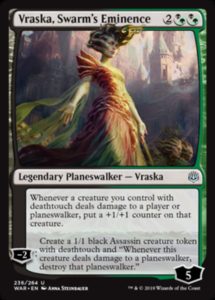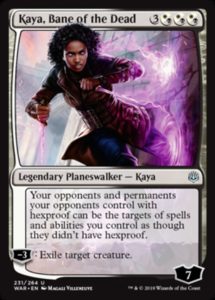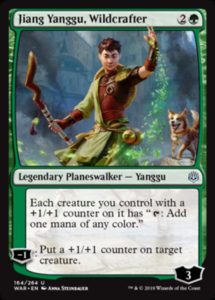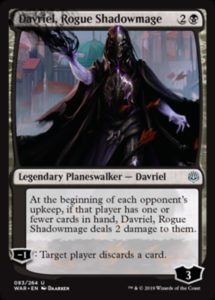Any cube designer knows that Planeswalkers are powerful, format-warping tools. If your format has too many planeswalkers, everything but the most powerful cards and combos fall aside as players grind out value every turn. This danger exists even if colors only have a few planeswalkers each. War of the Spark, however, will have a guaranteed Planeswalker in every pack. That’s twenty five planeswalkers minimum in every draft.
Last month, we explored this problem and considered possible solutions. That was done in the absence of any data. Today, more than half of the planeswalkers have been spoiled. So, let’s see how this is actually going to work and just how the set can possibly be balanced by looking at every uncommon Planeswalker spoiled by yesterday.
Assembling Armies
All of the uncommon Planeswalkers are restricted to two abilities: a static ability and a minus ability. Moreover, they tend to fit specific categories, so we’re grouping them together. Our larger category is Planeswalkers that produce creature tokens, essentially making them function as creatures. They all produce a token immediately, and if they survive a turn, can make another one and generate card advantage. After that, it’s a matter of Proliferating them to squeeze one more token out or protecting them to get value off of their static abilities. There are six such Planeswalkers, and they are:
- Teyo, the Shieldmage
- Tibalt, Rakish Instigator
- Vraska, Swarm’s Eminence
- Angrath, Captain of Chaos
- Kasmina, Enigmatic Mentor
- Arlinn, Voice of the Pack
Looking over them, we see a pretty clear pattern. Except for Arlinn, they all have the same initial loyalty (5) and loyalty cost (-2). However, their tokens and static abilities are of highly variable power level. Teyo produces the worst tokens and has an almost irrelevant ability (for Limited). Tibalt’s tokens aren’t much better and his ability is just as restricted. Tibalt basically makes you work to get a Dance with Devils, which while appropriate, isn’t exactly Koth of the Hammer-quality. This is a good start: these Planeswalkers function like Yargle, Glutton of Urborg—they’ll get to the person who really needs them, because they’re not particularly powerful. It’s good for the floor of uncommon Planeswalkers to be low, since it leaves plenty of room for many gradations of power. That said, if they’re the rare exception, rather than part of a power gradient, they’re pretty big booby prizes to open when everyone else is almost guaranteed a bomb.
Looking over the other four Planeswalkers, we see much more powerful tokens, more relevant static abilities. Vraska has the weakest static ability of the bunch, but a 1/1 super Deathtouch protects her well and a second token basically assures she produces card advantage. Angrath has an incredibly strong static ability in an aggressive deck, and guarantees that you get to put two power on the board. Kasmina provides mini-Hexproof to everything that matters in Limited, produces 2/2s, and produces virtual card advantage. And then there’s Arlinn, who bucks this trend and produces an army of 3/3s. All of these Planeswalkers are powerful, all can produce card advantage, and all appear to be first-pickable.
So, thus far, we’ve got two Planeswalkers who seem mere fodder (though Tibalt isn’t exactly unplayable) and four who seem like mini-bombs. If two-thirds of the Planeswalkers are bombs, this is going to be one difficult format to balance without also pushing the power level of creatures and interaction pretty hard. But, let’s move on to the next category and see how the Planeswalkers there pass muster.
Sorcerous Slaughter
These Planeswalkers function as removal spells. Their one activated ability is perhaps the most sought-after in Planeswalkers—the ability to protect themselves.
The Wanderer is the weakest of these three, since her static ability does little against nonred decks (and she can still be dealt noncombat damage) and her activated ability might miss entirely. But four mana for a Bring to Trial isn’t the worst thing in the world (particularly if creatures are big). She’s kind of the Tibalt of the group—certainly playable, but there are many circumstances in which she does nothing.
Nahiri is basically a Take Vengeance that also gives you great attacks and might be cast a second time. She can’t kill everything and she needs your opponent to cooperate (or for you to have a tapper) to kill what you want, but she dramatically changes the state of the battlefield while she’s around.
Kaya? Kaya is hard to cast and has basically no static ability, but that doesn’t matter. She kills your opponent’s best creature, and then if she lives (which isn’t unlikely, given that she just exiled the biggest threat), then she does it again. There’s a reason she needs to be Proliferated twice to gain an extra activation when most Planeswalkers only need a second Proliferate to reuse their -2: she’s super powerful.
Again, I’d put us at approximately a 2/3s success rate for bomb rate Planeswalker. Nahiri and Kaya drastically change the state of the game, and while The Wanderer is no slouch, she isn’t guaranteed that. Frankly, the only thing that prevents Kaya and Nahiri from being even more powerful is that they can’t produce value on their own—a Planeswalker like Teferi, Hero of Dominaria generates value on an empty board, but these women need your opponent to cooperate and provide fodder.
Amazing Auras
These Planeswalkers function like auras. They buff your forces and don’t do anything if you don’t already have a board presence. At present, there are two:
These two Planeswalkers play in very different veins from each other. Samut is an aggressive card and the first we’ve seen today that cannot produce card advantage. In fact, she’s the worst at protecting herself, because she encourages you to go on the offensive without producing tokens (as Angrath, Captain of Chaos does). That said, she’s basically In the Web of War, but cheaper, playable in two colors, and also a smoother of card draws. She’s the kind of Planeswalker you need to build your deck around, but also the kind of Planeswalker who can turn an average draw into an unstoppable one.
Jiang Yanggu produces more permanent advantage, but a bit more slowly. Of course, he also ramps you, which similarly can turn an average start into an explosive one. There’s nothing super exciting about him being a slow Travel Preparations, but the fact that he’s also Rishkar, Peema Renegade makes him pretty explosive, and there’s also the fact that he’s quite good with Proliferate.
Both of these Planeswalkers require decks full of creatures to function, making them harder to evaluate. You can’t windmill slam them the way you would a Kasmina or Kaya and put them into any deck that of the appropriate colors, but they’re still quite potent. I’m not sure whether they’re suitably bombs or not (playtesting is the only thing that can tell us that), but they sure seem close.
…and the rest
These three Planeswalkers are the wildcards of the bunch. They function differently from everything else, making them harder to evaluate.
Davriel Crane seems sweet. Mind Rot isn’t the worst Magic card (and yes, he makes you wait a turn for the effect), but he’s the best part of Liliana Vess at 60% of the mana cost and he comes with two thirds of The Rack. He’s cheap enough that it’s probably easy to protect him, he always trades for a card, and he can squeeze an entire card’s worth of value from every Proliferate. Even if your opponent tries to outsmart him by deploying all of their cards, he’ll still hurt them. He can’t win the game quickly by himself, but he’s a three mana splashable Planeswalker who provides guaranteed card advantage. That’s pretty damned strong.
Ob Nixilis, the Hate-Twisted is perhaps my favorite design seen today, because he’s so weird. He’s an excellent aggro finisher, since he can Searing Blaze anything (since your opponent is probably going to draw a card for turn before being able to do anything about him). Sure, you’re down a card whenever he kills something, but your opponent is down a creature and three life. That said, he can also be a card advantage outlet in a grindy aristocrats deck (which seems possible in the set). That’s some cool lenticular design, even if the sum of his parts likely don’t add up to a bomb.
And finally, there is Kiora, Behemoth Beckoner. Her minus ability is perhaps the less effective of every one. Sure, she has massive loyalty and ramps you, but Untamed Wilds isn’t a stellar card and she doesn’t fix your mana and she can get destroyed. Her power lies solely in being a card advantage engine (which granted, does synergize with her ability to ramp out expensive threats). Effects like Elemental Bond have never been particularly good, but Kiora helping to power out your threats could be enough to make her the linchpin of an archetype.
And that’s all 14 uncommon Planeswalkers spoiled so far reviewed. Vraska, Angrath, Kasmina, Arlinn, Nahiri, Kaya, and Davriel are definitely bombs in this author’s opinion. Samut and Yanggu are harder to evaluate, but both seem at least on the cusp of that tier. Even if they’re not, that’s a 50% success rate for uncommon Planeswalkers being game-warping. We’ll see what the other uncommon Planeswalkers bring to bear, but given the high apparent power level of those we already know, I’d expect lots of pushed common creatures (like Bloom Hulk) and removal (like Ob Nixilis’s Cruelty). Only time, and more spoilers will tell.
And, as always, thanks for reading.
—Zachary Barash is a New York City-based game designer and the commissioner of Team Draft League. He designs for Kingdom Death: Monster, has a Game Design MFA from the NYU Game Center, and does freelance game design. When the stars align, he streams Magic.
His favorite card of the month is Conviction. While initially designed as an aura that wasn’t nigh-guaranteed card advantage, it’s proven far more flexible over a decade later in sets like Aether Revolt (where it enabled Revolt) and Ultimate Masters (where it was quite strong alongside Heroic).





